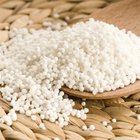Goldfinch4ever/iStock/GettyImages
If you or someone you cook for has food allergies, you need to find substitutes for many common ingredients, such as wheat flour and corn starch, depending on the source of the allergy. Certain ingredients, such as xanthan gum and potato starch, can perform the roles commonly taken on by other ingredients. Both are common in gluten-free baking and cooking, but they have slightly different characteristics and uses.
Xanthan Gum Basics
A common ingredient in both gluten-free recipes and processed foods, xanthan gum is the product of fermenting glucose with Xanthomonas campestris, a type of bacteria. Xanthan gum plays several roles in cooking. It acts as an emulsifier, which is why it's often used in bottled salad dressings. In a recipe for gluten-free bread, xanthan gum helps replace the gluten. It interacts with the starches in the recipe, trapping air and giving the bread some chewiness.
Potato Starch Basics
Potato starch is quite different from xanthan gum, both in terms of where it comes from and the role it plays in cooking. The starch is made up of long amylose chains, or straight chains of glucose. Potato starch is commonly used to thicken sauces and to give a lighter texture to gluten-free baked goods. Unlike other types of starch, such as cornstarch, potato starch is clear, has a moderate flavor and thickens at a relatively low temperature, between 136 and 150 degrees Fahrenheit. The downside is that the starch breaks down more quickly and can't withstand long cooking times.
Substituting for Wheat
You can use either xanthan gum or potato starch to replace wheat flour called for in a recipe for gravy, soup or stew. Since both ingredients have more thickening power than wheat flour or starch, you can use considerably less in a recipe. Use 1 1/2 teaspoons of potato starch to replace each tablespoon of wheat flour called for in a recipe, for example. You can use even less xanthan gum to replace wheat flour. Substitute 1 teaspoon xanthan gum for each tablespoon of wheat flour.
Concerns About Xanthan Gum
Although xanthan gum plays more roles in the kitchen than potato starch, a couple of factors might give you pause. For one thing, xanthan gum is considerably more expensive than potato starch. An ounce of xanthan gum can cost more than $1 while an ounce of potato starch can cost less than 30 cents, as of 2013. Xanthan gum can also cause gastrointestinal problems or bloating in some people, because it contains 7 grams of fiber per tablespoon.
Related Articles

How to Bake With Rice & Potato Flours

Ingredients of Gelatin

Flaxseed Meal Nutrition

How to Substitute Light Corn Syrup in a ...

Baking Soda Vs. Cream of Tartar

Can You Use Konjac Flour in Baking?

What Is the Nutritional Value of ...

Uses for Wheat Starch

How to Make a Foil Wrapped Potato

How to Replace Flour With Oat Flour

Fat-Free and Sugar-Free Jell-O Pudding ...

How to Cook Luglug Cornstarch Noodles

Russian Rye Bread vs. Pumpernickel
Arrowroot Starch As Tapioca Flour ...

Difference Between Canned Pumpkin & ...
Can You Replace Bulgur With Barley?

Kamut Nutrition

How to Use Guar Gum to Replace Gelatin

How to Substitute Cocoa Powder for ...

Substitute for Manioc Starch
References
Writer Bio
Based in Pennsylvania, Emily Weller has been writing professionally since 2007, when she began writing theater reviews Off-Off Broadway productions. Since then, she has written for TheNest, ModernMom and Rhode Island Home and Design magazine, among others. Weller attended CUNY/Brooklyn college and Temple University.